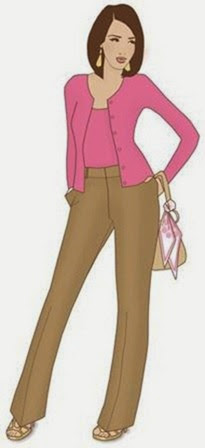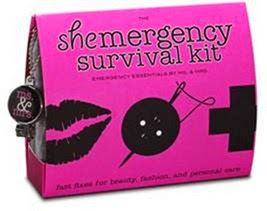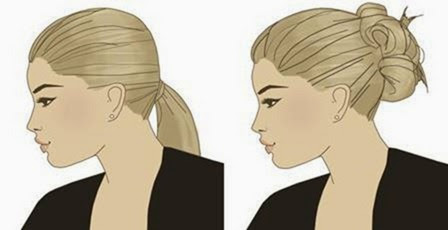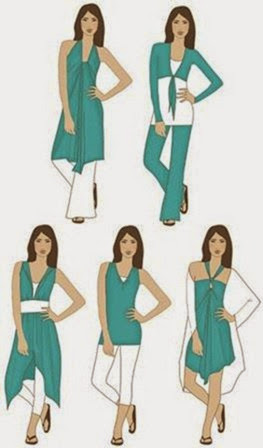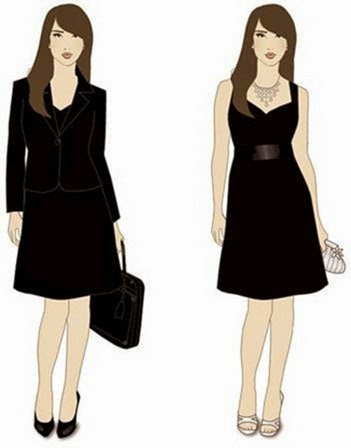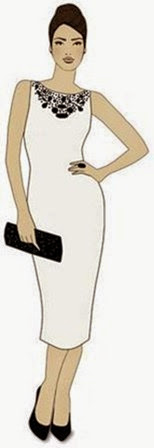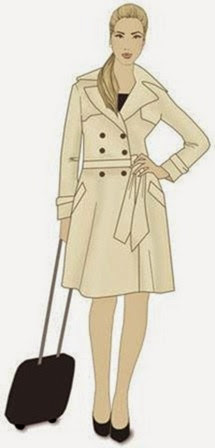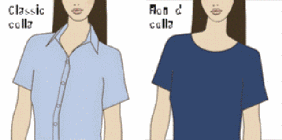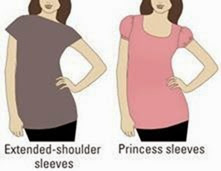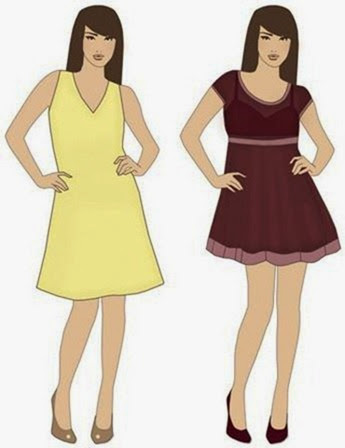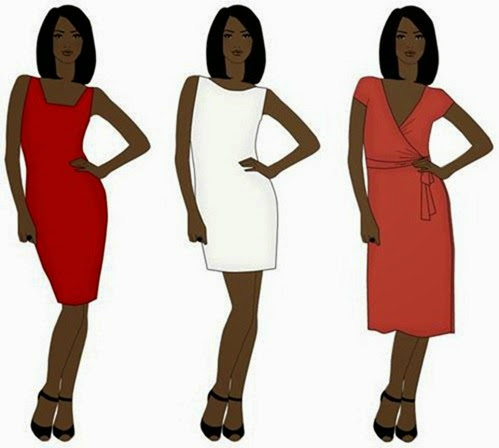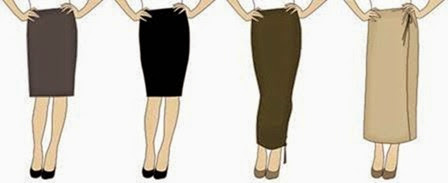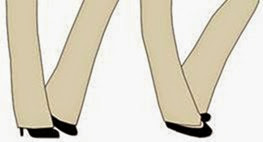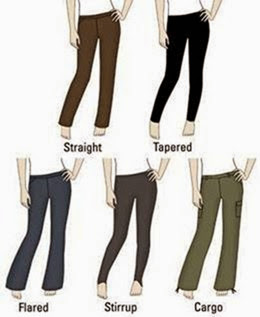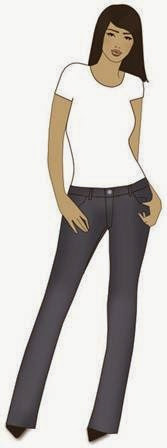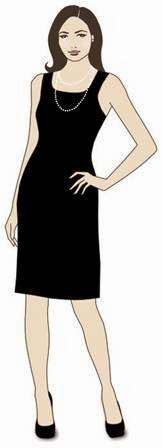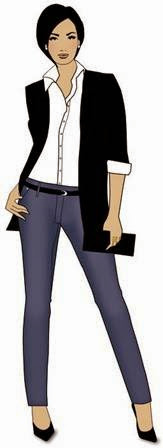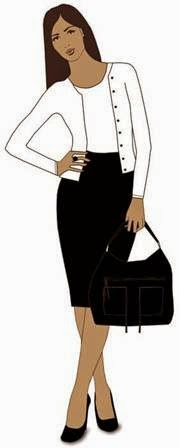Dressing for Success
In This Chapter
▶ Making your style work with your office dress code
▶ Looking great at off-site work events
▶ Packing for a business trip
Even though I consider myself a put-together person, whenever I do a segment on television, I am even more aware of what I look like and what I’m wearing. Of course, the content and the information I provide to viewers is the most important thing, but what I look like is also important. If I look disheveled, how on earth are viewers (including you, hopefully!) going to be able to concentrate, let alone trust, what I say? The same holds true in any profession. People who look put together give the impression that they have things under control and know what they’re doing.
When you look put together, your overall confidence improves, and that in turn helps you be more successful at work. Makes perfect sense, right? A recent survey conducted by careerbuilder.com offers support: Of the employers surveyed, 41 per- cent said they tend to promote people who dress professionally. In this chapter, I discuss not only hemlines, but also how to help your bottom line.
Deciphering Office Dress Codes
You can wear various types of clothing in a business environment, but the key to climbing the ladder of success is understanding which style in your place of business makes that climb go smoothly and quickly. The following sections outline the different categories for business dress.
Business casual
With business casual, you have the freedom to be a little more stylish and a lot less conservative. Instead of the traditional business suits, you can wear pants, blouses, skirts, and dresses. These selections make business casual more comfortable and give you the opportunity to inject some more of your personal style.
If you’re the slightest bit confused about what to wear as far as business casual, take a cue from the men in your office. If they’re wearing khakis and polo shirts, you can use that as the standard, even though you don’t want to wear exactly that. Your goal is to distinguish yourself in a way that makes you look both stylish and feminine. So instead of khakis, try sharp wool gabardine slacks or a pair of linen pants, and instead of a polo shirt, put on something more fitted that shows your curves without revealing any extra skin. Of course, if you do decide to wear khakis and a polo shirt (a preppy look), make sure the fit on each is a 10: The shirt should be fitted and in a feminine color (pink or another soft pastel), and the khakis can be capri length to show off your legs. Don’t forget a great pair of shoes (ballet flats are always chic yet comfortable). Figure 10-1 shows how a pair of khaki pants and ballet flats can be a stylish yet comfortable outfit for work.
Dealing with some of the challenges
Business casual may be one of the most common forms of dress these days, but with no exact definition, getting dressed in the morning can be complicated. When you just had to choose from one of the five suits you owned, the limitation made choosing your outfit
Figure 10-1: Business casual: Put together and comfortable.
for the day a lot easier (shopping was a lot easier, too). Now that you have a lot more options (pants, blouses, skirts, and more), the selection process
can be tricky. Following are some tips to help you adapt your business casual wardrobe when the need (or desire) arises:
✓ Keep a few items in your office to throw on when you need to. These items include a cardigan of neutral color and/or a scarf. Suppose you wear something to the office that’s a little on the edgier side and you have a meeting with a client late in the day and need to tone it down.
You can throw on the sweater or tie the scarf around your neck for a more conservative look.
Keep a perfect pair of black pumps and a perfect pair of black flats at work, too. You’ll be glad you have the flats if your feet are killing you, and if last minute plans come up, you can dress up your outfit with the black heels.
✓ Even if your place of work doesn’t require you to dress formally, show up decked out from time to time. You’ll feel great when people say “Wow, you look nice today!” It also helps people see you in a different light, which never hurts. And when people ask why the change (which you know some inevitably will), just say with confidence, “I felt like getting dressed up today.”
✓ You can be playful, but make sure it doesn’t turn from playful to too sexy. If you’re wearing a tight skirt that rides up when you sit and you’re in a business meeting, part of you will constantly worry about how much of your legs are showing instead of the subject matter being discussed. While you’re tugging at your skirt, you could be missing an impor-
Figure 10-2: Adding flair to business casual.
tant point, and others in the room may notice that you’re distracted. Plus any type of fidgeting often can be misinterpreted as anxiety or lack of preparedness. Why chance it?
Accessorizing to add flair
Aside from wearing more comfortable clothing, business casual dress is an opportunity to wear clothes with more flair. A scarf, earrings, and a nice pair of sandals can totally transform your work look (see Figure 10-2).
Accessories can be a quick fix when trying to make an outfit pop. If you’re wearing a simple outfit, you can use statement jewelry to express your per- sonal style. A chunky necklace or chandelier earrings can dress up any outfit, but don’t wear both — choose one or the other! Also don’t underestimate the power of a belt. An outfit that is simple or even a little roomy around the mid- section can be totally transformed with a great belt. Play around with it. If you do go the belt route, make sure you don’t over accessorize. Earrings or a bracelet (or even a small necklace) is fine. But just one is likely enough!
Casual
From business casual we move to simply casual. The distinction between the two is slight, but important: Business casual doesn’t incorporate jeans; casual can bring denim into the mix.
How casual you can go depends on the attitude of the office environment and the industry in which you work. In the fashion industry, a lot of the fash- ion PR companies tell their girls to dress casually. They want stylists to feel comfortable and relaxed when they walk in, so I often see women in jeans and funky tops, like the one shown in Figure 10-3. When I walk into a more corporate office environ- ment, the look and feel is a little more formal and conservative.
In casual work situations, jeans have become the go-to item. Obviously, jeans come in countless varieties. Some jeans scream casual; others can be chic and appropriate. A beautiful pair of nicely fitted, dark denim jeans are always appropriate in a casual work situation. Try them with a sophisticated blouse or sweater set for the office. Faded jeans with holes in the knees, on the other hand, are an entirely different story. Save those for the weekend.
If you dress casually every day, invest in a few great pairs of jeans and quality blouses and sweater sets. With these basics in your closet, you can make jeans fashionable yet appropriate for work. A fabulous sweater with a great scarf or a statement belt (or even a bold cocktail ring)
paired with jeans not only makes you stand out in
Figure 10-3: Done right, casual attire can be quite stylish.
the office, but it can also take you from day to night in a flash. Furthermore, if you’re wearing jeans and casual clothing to work, make sure you have a few great pairs of heels and at least one fabulous work tote. These items help pull an outfit together and make you look “done.”
Going casual without overstepping the bounds Casual clothing can be very tricky for women, especially during hot weather. Baring too much skin can become too sexy and provocative, which can create problems that can affect your work and work environment.
Are shorts ever okay? That’s a tough question. The easiest answer is a simple no, but there may be times when shorts are okay. First, never wear shorts to work unless you work in a very (and I mean very) casual environment. Second, if you’re going to break this rule, wear a pair of tailored shorts that hit right above the knee and pair it with a sweater set or blouse (see Figure 10-4).
Because shorts tend to be a very casual look, you can wear them with ballet flats or flat sandals, or, if you want to take it up a notch, you can wear them with heels.
Most firms that allow casual clothing do have some restrictions. Even if the policy is “anything goes,” you must remember to always dress appropriately. Take cues from your co-workers. Often your super- visor sets the tone. See what the appropriate level of dress is in your office, and add your personal flair to those clothes. For general expectations about any work attire, head to the later section “Universal rules for all kinds of business dress.” It’s always better to be a little overdressed than under- dressed. You can never go wrong if you follow this advice. In fact, people will end up looking to you to set the standard.
Figure 10-4: Long, tailored shorts paired with a blouse and heels can be casual yet chic.
Business conservative
Conservative business attire for women is a variation on the suit and tie requirement for men. You may wonder whether pant suits are as acceptable as suits with skirts. The answer is yes. A suit in almost any color (I would stay away from white in a work setting) paired with a blouse, camisole, or shell always looks professional and put together.
Be sure to put your own style into this look. If you love jewelry, try adding a bold necklace or earrings. Make sure your necklace lays properly and falls in the right place and doesn’t compete with the neckline of your top or suit jacket. And keep the earrings on the smaller side or just wear studs (you don’t want your earrings to make you look like you’re going out for a night on the town).
Getting that polished look
Business formal for the woman who wants to look fashionable means being both professional and polished. To accomplish that, do the following:
✓ Buy nicer quality suits. You may not want to spend a fortune on the suits you wear to the office, but you do spend a huge portion of your time at work and in those suits. For that reason, spending a little more money to feel and look great is a good investment.
✓ Stick with suits in darker colors. You can tell more easily the quality of the material when the color is lighter. So if you’re buying a suit that’s not of the highest quality, it will be less noticeable in a darker color, which is why most people default to buying black.
✓ Make sure that whatever you wear fits properly. If you need to, spend a little more to get your suits altered.
✓ Keep your suits in great condition. Dry-clean them whenever necessary (do both jacket and pants or skirt together to keep the colors on both pieces looking the same) and possibly invest in a home steamer for last minute touch ups. You don’t have to dry-clean every time you wear a suit. I recommend just steaming it for the second wearing. Depending on how grueling your work days are, you can usually get away with wearing a suit two to three times before dry-cleaning it.
✓ Make sure that every item you wear complements the other items. Haphazardly throwing together your bag, blouse, and shoes projects an overall look of disorganization. Everything you wear from your coat to your scarf to your shoes, must (in some way) work together.
✓ Make sure your coat and briefcase (or work bag or tote) are as polished and refined as you are. What you look like when you enter and leave the building can leave a lasting impression. Nothing is worse than a fabulous woman in a great suit with the wrong outerwear. It’s like a great present with the wrong wrapping.
Being prepared for emergencies
To keep up your polished appearance, be prepared for emergencies because accidents do happen. If your hose or tights catch on your desk and rip, make sure you have another pair on hand so that you can dash to the ladies room before that big meeting. (Nail polish or hairspray also prevents a run from spreading.) And because winter time means static, keep static guard handy in case your skirt clings to your legs. A lint remover is another handy thing to have close by. For clothing rips, a piece of tape on the inside can keep you going for the rest of the day.
A convenient and relatively inexpensive way to be ready for any accident is to buy a Shemergency Survival Kit (see Figure 10-5). It holds mini-versions of everything you need in the event of a fashion emergency: folding hairbrush, hair spray, emery board, nail clipper, nail polish, nail polish remover, static remover, breath freshener, safety pin, shoe shine wipes, dental floss, pain reliever, double-sided tape, deodorant wipes, tampon, adhesive bandages, facial tissues. Can you believe it — all these items fit into this hand size pouch and the whole thing costs only $20! You can find one at www.msandmrs.com.
©Georgette Kaplan, Shemergency Survival Kit™ by Ms. & Mrs.
Figure 10-5: The Shemergency Survival Kit.
Letting your style stand out
Even if the attire is more formal at your place of work, you can still dress appropriately while expressing your personal style. To dress up a suit, a sweater set, or a simple blouse and look sharp and stylish while still maintaining a more formal look, use the following suggestions:
✓ Wear statement jewelry: Statement jewelry is a great way to make a simple suit stand out (and it can also work as a talking point). If you wear a bold necklace, bracelet, ring, or earrings, someone is likely to say, “I love that! Where did you get it?” This may strike up a conversation with a co-worker you’ve never had interaction with before. It may sound silly, but that’s how relationships start sometimes!
✓ Wear something other than pumps, if allowed. If you’re in a conservative environment, pumps are definitely the safe way to go, but if you have some leeway, sandals are a great way to express your style. If you’re required to wear hose, wear a closed-toe shoe, no matter the season. Look to the women in higher positions to see what’s accept- able in terms of shoes and hosiery. (For more on these topics, head to Chapters 14 and 16.)
✓ Have fun with your hair. Changing your hairstyle every so often can give you a new look without having to go out and buy a new wardrobe. Just always make sure your style looks clean and neat.
If your hair covers your face or your bangs get in your eyes, your hair will be seen as an encumbrance to working most effectively. Need a stylish solution? Put your hair back in a sleek low ponytail or loose bun (see Figure 10-6).
Figure 10-6: Two perfectly acceptable hairstyles in any office setting.
You always want to feel and look your best, but remember to keep your audience in mind. Your goal is to wear what you’re comfortable in and also make the person or people you’re meeting with feel like you’re on the same page. In a work situation, you want to make the people you’re meeting with feel confident in your abilities. The way you look has a huge impact on how they perceive you before you even say a word. So if you’re meeting someone who’s on the more conservative side, dress more conservatively. If you’re meeting with someone you know is on the trendier side, grab that trendy bag (or pair of shoes) you’ve been dying to wear.
Universal rules for all kinds of business dress
Understanding exactly what a business’s dress code is (and consistency in enforcing such a code) would certainly take some of the guessing out of what to wear to work. But some types of dress don’t fly in most offices. In the same careerbuilder.com survey, 64 percent of employers said they banned flip- flops, 49 percent said no to miniskirts, and 28 percent didn’t allow jeans.
Whether dress code rules are written down in your office or not, certain guidelines are pretty universal:
✓ Whatever you wear to work, make sure it’s neat. No wrinkles or tears. If you have a pair of capri pants, but you’re not sure they’re appropriate, try ironing them. Being crisp and neat may put them over the edge from unacceptable to acceptable.
✓ If one part of your outfit may be pushing the envelope, pair it with something conservative. A sleeveless blouse, for example, can be acceptable when you wear it with a conservative skirt.
✓ Stay away from showing too much cleavage or wearing something too revealing. Tops made of translucent or wispy material are inappropriate, unless you wear a tank or camisole underneath it. And if you find yourself wondering, “Is this too much cleavage?” it’s too much. While showing cleavage can be sexy and appropriate in the evening, it’s unnecessary and distracting in the office. Worse, it can undermine the impression of professionalism you want to exude. That doesn’t mean you can’t wear a blouse with buttons or a V-neck, just err on the side of more conservative in the office.
Dressing for Off-site Work Events
Some people travel all the time — the road warriors — while others rarely leave the office. If you’re going on a quick jaunt that doesn’t require an over- night stay, your challenge is to try to keep your clothes looking fresh after you’ve been on the road for a few hours. On longer trips, you have a variety of challenges, like what to wear on the plane, what’s appropriate attire for the various activities and venues you may be at, and how to pack everything you need.
Looking stylish en route
You may be tempted to wear just any old thing on the plane (or bus or train) and change at the hotel, but I advise against it. First, lost luggage or a delayed flight can end up causing a problem. Second, you should always look your best while flying because you never know who you may meet (yes, I know I sound like your mother). The trick for dressing for the flight is to find clothing that is stylish, comfortable, and resistant to wrinkles. Some materials that fit the bill are
✓ Wool and silk: These fibers (refer to Chapter 4) have natural elasticity, which helps keep them from wrinkling.
✓ Synthetic fabrics: Fabrics such as nylon and polyester are less prone to wrinkling.
✓ Fabrics that use finishing agents designed to reduce wrinkles: Textile manufacturers began to add finishing agents to their cloths that change
the chemical structure in such a way as to make fabrics that once wrinkled easily, like cotton, wrinkle free. When purchasing garments for travel, look for pieces that say they’re wrinkle resistant and still 100 percent cotton. Some wrinkle resistant garments aren’t all cotton, but cotton polyester blends.
✓ Knits: Knits wrinkle much less than woven fabrics, so anything that’s a cable, ribbed, tricot, or jersey knit will remain wrinkle free. If you rollknit s instead of folding them when you pack, they come out of your suit- case wrinkle and fold free.
The Donna M clothing line (www.bbydonnam.com) sells something called the 5 Piece Wardrobe (see Figure 10-7). Most of the items are under $100, and you can mix and match them hundreds of different ways. The pieces are comfort- able, don’t wrinkle, and will take you from day to night in a flash. I wear them whenever I fly.
![]() b® by donna.m — www.bByDonnaM.com
b® by donna.m — www.bByDonnaM.com
Figure 10-7: The Donna M 5 Piece Wardrobe is perfect for travel
Wrinkles can get you coming and going. So pay attention to how you look from the rear as well as the front. If your pants are creased in the back or the label on your blouse is sticking up, you may make a good first impression but a lousy parting one. So check both the front and back in a mirror before you head to that meeting.
Daytime casual
Daytime casual varies from industry to industry and from state to state. What you may wear to a luncheon in New York among people in finance is different from what you’d wear to a meeting in Los Angeles with people in the film industry. Most businesses have their own definitions of daytime casual. Unless you’ve been to a particular event or a place many times before, play it safe and slightly overdress. Better to feel a little uncomfortable because you’re slightly overdressed than to feel very uncomfortable because you’re underdressed.
One way to handle this type of dilemma is to dress in layers or use versatile accessories. If you’re wearing a jacket and no one else is, simply take the jacket off and you’ll fit right in. A silk scarf worn around your neck can make an outfit seem more formal. If it makes you seem too formal, you can simply take it off.
When you’re away from the office, sharing a meal with your colleagues is very common. If you know ahead of time where you’re dining, check out the restaurant’s Web site to get an idea of how formal or casual it is. That way, you’re prepared for each scenario.
If you travel for business, you’ll probably try to pack as few clothes as possible so that you don’t have to check your luggage. Convenient, yes, but it means you won’t have a spare blouse or skirt to change into if the one you’re wearing gets stained. Some materials are more stain resistant than others, and for those pieces that need more protection, you can use Scotchgard. Taking such garments on trips can be a good form of stain insurance. A quick and easy alternative, though, is to use a Tide Stain Stick, which removes stains on the spot. (I use my stain stick all the time!) Simply take off the cap and press down on the tip to release the stain fighter directly onto the stain. (Use cau- tion depending on the material and item you’re wearing.)
Daytime conservative
Some business trips or events require you to get dressed up. Perhaps you’re a lawyer going to court or pitching a new business to a firm. For men, the decision of what to wear is fairly easy because the key word is conservative. For women, dressing conservatively is a bit more vague. While dressing more conservatively used to mean wearing a skirt rather than pants, that’s no longer the case.
A suit (pants or skirt) always works well. Alternatively, a pencil skirt paired with a blouse or sweater set and accessories works in almost any setting. What about a dress instead of a suit? Yes, as long as it’s a simple dress (especially with a blazer over it) — no cocktail or sexy dresses! It doesn’t need to be black, but it should be conservative in color; a conservative print is fine, too. Even a sleeveless dress that hits below the knee is perfectly okay.
Each situation is different, but the old way of thinking — that a woman must wear a suit for a presentation or big meeting — is antiquated. The key is to know your audience. And if you don’t, you’re better off being as conservative as possible. No one will fault you for being too conservative, but if you’re not conservative enough, someone may immediately judge you as a person who doesn’t “get it”— a group you never want to be in!
Feeling confident is so important, and finding the right mix between dressing appropriately and dressing with confidence is the ultimate goal in any situation. Even if you have to dress conservatively, it’s sometimes fun (and appropriate) to switch it up. So pack a colorful scarf and some dangly earrings, and if it seems like you can get away with standing out a bit, go for it.
Evening casual
It’s always good to feel like you’re wearing the right thing from the second you walk in, but evening casual gets a little tricky. A cocktail party could be at the fanciest hotel in town or a pub down the block. A trip to a ballgame could be in the stands or in a company box with a waiter in a tux. Following are some suggestions:
✓ The little black dress (LBD): You can rarely go wrong with the LBD (see Chapter 7) and a pair of perfect pumps. It’s the perfect solution if you know you’re going out after work straight away. To work, wear the dress with a blazer, pumps, and work tote; for evening, simply take off the blazer, switch out your shoes and bag, and add some dressy jewelry (see Figure 10-8).
✓ Statement jewelry: Adding bold jewelry is a great way to make your outfit more exciting.
✓ A suit with something pretty underneath: An outfit like this takes you from day to night and is the perfect solution if you know you’re going out after work straight away. If you wear a pant suit with a pretty blouse or tank underneath, you can go from your business meeting to a cocktail party simply by removing the jacket.
Figure 10-8: With the right basics, you can easily go from work wear to social wear.
Of course the final decision about what to wear depends on the activity involved. Dinner at a barbeque restaurant obviously rules out your LBD. There is nothing wrong (by the way) in saying to a co-worker you trust, “What are you wearing tonight?”
Evening fancy
A business black-tie affair is not a wedding or a party with friends, where you may want to show off your fabulous back or beautiful cleavage. Leave that look for your next big social
event. At a business event, even one where you need to dress to the nines, keep your outfit stylish but work-appropriate at the same time (see Figure 10-9). Following are some guidelines:
✓ Don’t wear anything too revealing. “Too revealing” is anything that implies sexy, especially when it comes to cleavage, though in some situations, you also want to make sure your upper arms and back are covered, too. If you decide to wear something that you have in your closet already but that may be too revealing on top, a wrap is always a great solution. It covers you up a bit while maintaining a pulled together and, depending on the wrap, dressy look. Many kinds of wraps are available, some with beading, that are perfect for evening wear.
✓ Choose an outfit that’s relatively easy to put on. You may not have a lot of time to change. If you have business meetings during the day, the meeting may run longer than expected. If you don’t have a female associate with you to zip you up, you’d better wear something that you can get in and out of on your own.
Figure 10-9: An outfit that’s elegant without being too sexy.
✓ Make sure whatever you take looks great once it comes out of your suitcase. A great trick to get rid of wrinkles is to turn your shower on hot and close the bathroom door. The steam from the shower helps take out any wrinkles and generally freshens up your outfit.
Your gown should be modest but it doesn’t have to be dowdy. Take advantage of embellishments like beading, embroidery, rhinestones, velvet, and metallic pieces to give your look some sparkle. Make sure that you have a matching evening clutch because, again, everything should be fabulous like you. Buying a great silver or gold clutch to keep in your wardrobe is always a good idea as it can work with many different outfits.
All these warnings don’t mean that when you go out with co-workers, you can’t show a different side of yourself. Business black-tie affairs are prime opportunities to let co-workers see glimpses of what you’re like outside of the office (which is often interesting and fun). But you have to walk a fine line. If you have any question about whether something will work, don’t wear it. It’s better not to test the water until you know for sure.
If you don’t have a great work-appropriate formal dress and you’re just finding your personal style, a black cocktail dress is always a safe bet and works well for many occasions. Choose one with a conservative neckline that doesn’t show cleavage. Some good options include a basic round neck, a square neck, or a boat neck (Chapter 9 describes the different kinds of necklines). Sleeveless can work if you pair it with a shawl or shrug that you can remove if appropriate.
Packing for a Business Trip
When you pack for a vacation or a weekend getaway, you usually have the luxury of packing more than you need. If you can’t decide between the strappy sandals and sparkly sling-backs, you can pack both and decide later. Packing for a business trip is an entirely different thing. Your goal is to pack the most functional clothing into the least amount of space because if you can avoid having to check your luggage, all the better.
You’ve seen the road warriors. They travel differently than everybody else. First, they’re usually carrying around a lot of electronic equipment, heaviest of all being their laptop computer and battery pack. Second, they almost never check their luggage (see Figure 10-10). They manage to fit everything into a carry-on.
Yes, packing everything you need into one case is a challenge, but it’s a must for an overnight trip. And it’s completely doable. Here’s how:
✓ Wear the clothing that’s going to take up the most room in your luggage. If a blazer is required, wear it on board. You can probably hang it up once you’re on the plane. If you’re flying from a warm climate to a colder one, wear your overcoat and stick it in the overhead compartment when you get on the plane. If you absolutely need two pairs of shoes, wear the one that would take up the most luggage space (which are hopefully the ones that are more comfortable).
✓ Roll, rather than fold, your
clothing. As I said earlier, knits make great travel clothes because they can be rolled up without wrinkling. In fact, any type of clothing generally accumulates less wrinkles when rolled. Clothes made with spandex or polyester blends throw off wrinkles no matter how you pack them. (These fabrics are good not only for packing, but also for sitting in long meetings.)
Figure 10-10: Ready for a business trip.
✓ Make sure everything you take can be mixed and matched. If you’re going for two days, you need to pack only one and a half outfits rather than two. Black is an especially good color to wear because it doesn’t show any stains that may splash your way.
✓ Choose things that you can wear multiple times. If you have a pair of straight-legged black pants and a black pencil skirt (which has less fabric so packs easier) and a pair of black pumps, all you need are a couple of monochromatic tops and you can go for quite a few days that way.
✓ Choose lighter rather than heavier clothing. Because it may be cold on the plane and many airlines no longer give blankets, a cardigan is a good idea because it can also substitute for a jacket. Instead of bringing jeans to lounge in your room (if you don’t plan to wear them when you’re not working), take along a pair of lightweight sweat pants instead. They take up less space.
Though more companies are cutting their travel budgets these days, busi- ness travelers will never completely disappear. If you find yourself one of them, don’t allow being on the road make you any less fashionable.


